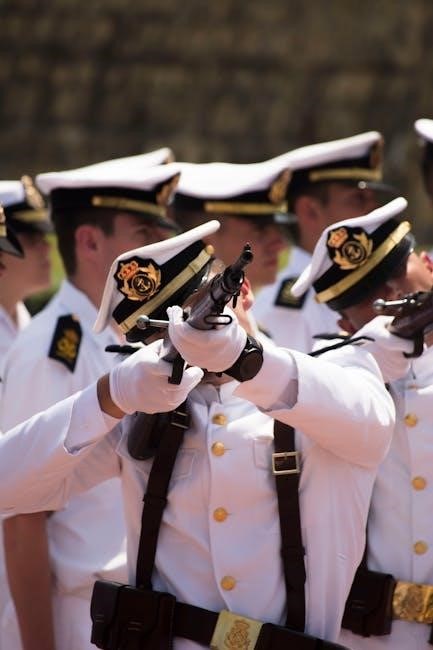Overview of Navy Drill Manuals
Navy Drill Manuals serve as comprehensive guides‚ providing information on military drill ceremonies and uniform regulations. These manuals are substantial‚ sometimes exceeding 500 pages‚ and are essential for instilling discipline and unity within naval ranks.
Purpose and Scope of Navy Drill Manuals
The primary purpose of Navy Drill Manuals is to provide detailed guidance on conducting military drill ceremonies and adhering to uniform regulations. These manuals aim to instill discipline and a sense of unity among all ranks within the Navy. The scope encompasses various aspects of naval procedures‚ from basic drills to more complex battle drills and ballast control operations. Drill manuals also cover specific regulations for specialized units like the Hospital Corps‚ ensuring standardized practices across the entire naval force. They outline procedures for sections to follow before‚ during‚ and after combat engagements.

Historical Context
The evolution of Navy drill manuals reflects a rich history‚ influenced by global naval powers. Notably‚ Swedish influence played a role in shaping early Russian naval artillery drill regulations.
Swedish Influence on Russian Naval Artillery Drill Regulations
During the time of Peter the Great‚ Swedish naval practices significantly impacted the development of Russian naval artillery drill regulations. K.B. Nazarenko’s research highlights this influence‚ revealing previously unknown aspects of 18th-century Russian naval artillery exercises. This historical connection underscores the importance of cross-cultural exchange in shaping military doctrine and procedures. The adoption of Swedish methods facilitated advancements in Russian naval capabilities‚ contributing to its emergence as a formidable maritime power. Understanding this historical context provides valuable insights into the evolution of naval warfare and training.
Evolution of Drill Regulations Over Time
The evolution of drill regulations reflects adaptations to changing naval technologies and operational requirements. Initially influenced by Swedish practices‚ Russian naval artillery drills underwent continuous refinement. Over time‚ drill manuals expanded to encompass various aspects of naval operations‚ including hospital procedures and combat tactics. The U.S. Navy Regulations and Marine Corps Drill and Ceremonies Manual have been revised to reflect modern practices. These evolutions ensured that naval personnel remained proficient in executing essential tasks‚ maintaining combat readiness and upholding standards of discipline and precision. The continued adaptation of drill regulations underscores their vital role.

Key Components of a Navy Drill Manual
Navy drill manuals encompass military drill ceremonies‚ uniform regulations‚ and specific procedures. They provide guidance for hospital corps drills‚ ballast control‚ and battle drills‚ ensuring comprehensive training and standardized practices.
Military Drill Ceremonies and Uniform Regulations
Military drill ceremonies‚ detailed within Navy drill manuals‚ emphasize precision and discipline. These sections cover ceremonial parades‚ barracks regulations‚ and duties for various branches‚ including the Royal Navy‚ Marines‚ and Army. Uniform regulations are also extensively detailed‚ providing guidance on proper attire and appearance. The manuals outline protocols for drill competitions‚ leadership roles‚ and adherence to Navy regulations. These components aim to instill unity‚ respect‚ and professionalism among naval personnel‚ ensuring seamless execution of military ceremonies and maintaining a high standard of uniform presentation across all ranks.
Hospital Corps Drill Regulations
Hospital Corps Drill Regulations are specialized sections within Navy drill manuals‚ tailored for medical personnel. These regulations‚ historically prepared under the Surgeon General’s direction‚ address specific drills and procedures relevant to the Hospital Corps. They cover aspects of hospital management‚ administration of naval medical support‚ and the unique responsibilities of corpsmen. The regulations also emphasize discipline and unity within the medical ranks‚ ensuring efficient and coordinated responses in medical scenarios. The manual also helps prepare the Hospital Corps to provide support in various situations‚ including field exercises and medical emergencies‚ ensuring a high standard of medical care.
Specific Drill Types and Procedures
Navy drill manuals detail specific drill types and procedures‚ including ballast control operations and battle drills. These drills ensure readiness for various scenarios‚ from routine tasks to combat engagements‚ improving operational effectiveness.
Ballast Control Operations
Ballast control operations‚ as outlined in Navy drill manuals‚ are crucial procedures‚ especially for vessels like barges. These operations involve managing the distribution of weight within the ship to maintain stability and trim. Proper execution of ballast control is vital for safe navigation and operational efficiency. The drill manuals provide comprehensive training for personnel involved in these operations‚ including those seeking licenses as Officers in Charge of a Marine Engineering Watch (OIM) or Barge Supervisors. Mastering these drills ensures the vessel can handle various sea conditions and cargo loads effectively.
Battle Drills
Battle drills‚ integral to Navy drill manuals‚ are standardized procedures designed to prepare naval personnel for combat engagements. These drills cover actions before‚ during‚ and after combat‚ ensuring a coordinated and effective response; Specifically‚ battle drills encompass preparing equipment‚ executing tactical maneuvers‚ and maintaining situational awareness under pressure. The Six Section Battle Drills‚ for instance‚ outline procedures for sections to follow in various combat scenarios. Regular practice of these drills instills muscle memory and promotes quick decision-making‚ enhancing the overall combat readiness of naval units in dynamic and high-stress environments‚ ensuring mission success.
Multinational Naval Exercises
Multinational naval exercises like AMAN (Peace) enhance regional maritime security. These exercises‚ often biennial‚ involve numerous countries and aim to improve interoperability among allied forces through coordinated drills and simulations.
AMAN (Peace) Exercises
AMAN (Peace) exercises are biennial multinational naval drills hosted by the Pakistan Navy. These exercises aim to enhance regional maritime security and foster interoperability among participating allied forces. With participation from numerous countries‚ including nations like Türkiye‚ AMAN exercises provide a platform for navies to collaborate and improve their collective capabilities in addressing maritime threats. The exercises typically span several days and involve a range of activities‚ including simulated scenarios and live-fire drills‚ promoting cooperation and understanding among participating nations‚ contributing to stability in the maritime domain.

Regulations and Compliance
U.S. Navy Regulations govern the conduct of all personnel. Drill manuals align with these regulations‚ ensuring compliance. These regulations are issued in accordance with the provisions of Title 10‚ United States Code‚ Section 6011.
U.S. Navy Regulations
U.S. Navy Regulations are fundamental to the governance of all individuals within the naval service. These regulations‚ often referenced in drill manuals‚ ensure adherence to established standards and protocols. Compliance with these regulations is paramount for maintaining order‚ discipline‚ and operational effectiveness. The regulations are issued under Title 10‚ United States Code‚ Section 6011‚ which provides the legal framework for naval governance. Drill manuals incorporate these regulations to guide personnel in their duties and responsibilities‚ promoting a culture of compliance and accountability throughout the Navy. They are essential for the government of all persons.
Training and Education
Curriculum requirements include compulsory physical drills‚ swimming‚ and exercises. Students are tested on drill‚ uniforms‚ recruit training order‚ and squad bay procedures‚ ensuring comprehensive preparation for naval service.
Curriculum Requirements Including Physical Drills
Navy training programs necessitate rigorous curriculum requirements‚ incorporating compulsory physical drills‚ swimming proficiency‚ and extensive exercises. These elements are crucial for developing the physical and mental fortitude required of naval personnel. Recruits undergo testing on a variety of subjects‚ including drill techniques‚ uniform regulations‚ recruit training protocols‚ and squad bay procedures. Initial drill sessions are conducted at designated times‚ overseen by the Officer in Charge‚ to ensure adherence to standards. This comprehensive approach ensures that all personnel meet the Navy’s stringent requirements for physical fitness and procedural knowledge‚ fostering a disciplined and capable force.

Availability and Access
Navy drill manuals‚ some substantial documents exceeding 500 pages‚ are prepared for release and guidance. Access to these resources is essential for personnel requiring detailed procedural information and uniform regulations.
Large Manuals Over 500 Pages
Certain Navy drill manuals are extensive documents‚ often exceeding 500 pages in length. These comprehensive manuals provide detailed information and guidance on a wide range of topics‚ including military drill ceremonies‚ uniform regulations‚ and specific procedures. Due to their size and scope‚ these manuals represent a significant resource for naval personnel seeking in-depth knowledge and understanding of naval protocols. Preparing these documents for release involves a thorough review process to ensure accuracy‚ completeness‚ and adherence to current regulations. The substantial content reflects the complexity and detail required for effective naval operations and training.
